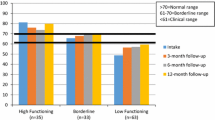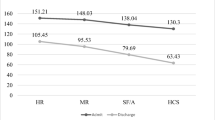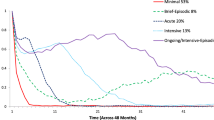Abstract
We aimed to identify profile characteristics for a recent sample of young residential children, examine the differential impact that profile characteristics have on behavior change, and describe the relationship between behavioral symptomatology and length of stay in residential treatment. A sample of 142 consecutively admitted residential treatment children were studied over a five-year period. Hierarchical Linear Modeling was the primary statistical method used to analyze behavioral rating data for a subset of 57 children assessed by teachers and treatment staff using the Devereux Scales of Mental Disorders. Younger age, female gender, and lower IQ were associated with increased levels of psychopathology. Residential length of stay was strongly linked to levels of behavioral symptomatology. HLM is a valuable analytic strategy that employs client profile characteristics to model behavioral change trajectories and help predict treatment responsiveness. System reform philosophies that promote expectations for rapid symptom improvement and removal of residential treatment from the continuum of care may exceed current treatment capacities.
Similar content being viewed by others
REFERENCES
Asarnow, J.R., Aoki, W., & Elson, S. (1996). Children in residential treatment: A follow-up study. Journal of Clinical Child Psychology, 25, 209–214.
Bryk, A.S., & Raudenbush, S.W. (1992). Hierarchical linear models: Applications and data analysis methods. Newbury Pak, CA: Sage Publications.
Burns, B.J., & Friedman, R.M. (1990). Examining the research base for child mental health services and policy. The Journal of Mental Health Administration, 17, 87–98.
Cohen, P. (1996) Childhood risks for young adult symptoms of personality disorder: Method and substance. Multivariate Behavioral Research, 31, 121–148.
Corrigan, J. M., & Martin, J. B. (1992). Identification of factors associated with hospital readmission and development of a predictive model. Health Services Research, 27, 81–101.
Courtney, M. (1994). Factors associated with entrance into group care. In R.P. Barth, J.D. Berrick, & N. Gilbert (Eds.), Child welfare research review, Vol. 1 (pp. 185–204). New York: Columbia University Press.
Curry, J.F. (1991). Outcome research on residential treatment: Implications and suggested directions. American Journal of Orthopsychiatry, 61, 348–357.
Farmer, E.M.Z. (2000). Issues confronting effective services in systems of care. Children and Youth Services Review, 22, 627–650.
Guo, S., Hussey, D. (1999). Analyzing longitudinal rating data: A three-level hierarchical linear model.Social Work Research, 23, 209–272.
Hoagwood, K., & Cunningham, M. (1992). Outcomes of children with emotional disturbance in residential treatment for educational purposes. Journal of Child and Family Studies, 1, 129–140.
Howard, K.I., Kopta, M., Krause, M.S. & Orlinsky, D.E. (1986). The dose-effect relationship in psychotherapy. American Psychologist, 41, 159–164.
Loeber, R. (1982). The stability of antisocial and delinquent child behavior: A review. Child Development, 53, 1431–1446.
Loeber, R. & Keenan, K. (1994). Interaction between conduct disorder and its comorbid conditions: Effects of age and gender. Clinical Psychology Review, 14, 497–523.
Moffitt, T., Caspi, A., Dickson, N., Silva, P., and Stanton, W. (1996). Childhood-onset versus adolescentonset antisocial conduct problems in males: Natural history from ages 3 to 18 years. Developmental and Psychopathology, 8, 399–424.
Naglieri, J., LeBuffe, P., & Pfeiffer, S.I. (1994).Devereux Scales of Mental Disorders. The Psychological Corporation, TX: San Antonio.
Pfeiffer, S.I., & Strzelecki, S. (1990). Inpatient psychiatric treatment of children and adolescents: A review of outcome studies. Journal of the American Academy of Child and Adolescent Psychiatry, 29, 847–853.
Pottick, K., Hansell, S., Gutterman, E., & Raskin-White, H. (1995). Factors associated with inpatient and outpatient treatment for children and adolescents with serious mental illness. Journal of the American Academy of Child and Adolescent Psychiatry, 34, 425–433.
U.S. Department of Health and Human Services (2001, April). The AFCARS Report, Administration for Children and Families, Administration on Children, Youth and Families, Children's Bureau, www.act.dhhs.gov/programs/cb.
Author information
Authors and Affiliations
Corresponding author
Rights and permissions
About this article
Cite this article
Hussey, D.L., Guo, S. Profile Characteristics and Behavioral Change Trajectories of Young Residential Children. Journal of Child and Family Studies 11, 401–410 (2002). https://doi.org/10.1023/A:1020927223517
Issue Date:
DOI: https://doi.org/10.1023/A:1020927223517




